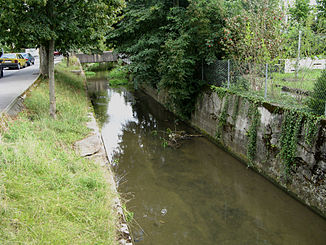Stadtbach (Aarau)
| Stadtbach | ||
|
Stadtbach |
||
| Data | ||
| Water code | CH : 13054 | |
| location | Switzerland | |
| River system | Rhine | |
| Drain over | Aare → Rhine → North Sea | |
| source | west of Suhr 47 ° 22 ′ 10 ″ N , 8 ° 3 ′ 52 ″ E |
|
| Source height | 403 m above sea level M. | |
| muzzle | near the old town of Aarau Coordinates: 47 ° 23 ′ 42 " N , 8 ° 2 ′ 34" E ; CH1903: 645609 / 249 539 47 ° 23 '42 " N , 8 ° 2' 34" O |
|
| Mouth height | 371 m | |
| Height difference | 32 m | |
| Bottom slope | 7.1 ‰ | |
| length | 4.5 km | |
The Stadtbach is an artificially created stream in the canton of Aargau in Switzerland in the 13th century . It rises in the area of the municipality of Suhr and flows through the city of Aarau , where it flows into the Aare after around four and a half kilometers . Up until the middle of the 19th century, the Stadtbach was used to supply Aarau with drinking water.
course
The stream begins in the Brüelmatten, a plain between Unterentfelden and Suhr. There it is fed on the one hand by various groundwater sources on the southern edge of the Gönhardwald, on the other hand water is also supplied from the Entfelder Dorfbach, the Suhre and the Uerke . Up to the village center of Suhr, where part of the water is fed back into the Suhre, the water is called Brunnbach.
In Suhr, the city stream circles the church hill and turns to the northwest. For the next three kilometers, he follows Bachstrasse, past the Brügglifeld stadium and the Herosé monastery . From the upper suburb, the city stream is largely overturned . After passing the rear suburb and the upper gate , it reaches the old town and branches into three arms. The western arm leads through Rathausgasse and Zollrain, the middle one through Pelzgasse and Metzgergasse, and the eastern arm through Färbergässli and Mühlegässli. In the area of the former hammer mill they reunite and a few meters later the Stadtbach flows into the Aare. A small branch ran through the Vordere Vorstadt and then flowed off to the west via the former city moat.
history
It is not known exactly when the Stadtbach was built, but it must have been between 1248 (oldest evidence of the place name) and 1292 when Duke Albrecht I allowed the Aarau residents to tap into the Suhre. There were often disputes between Aarau and Suhr over water use. In 1517, Bern decided that if there was a water shortage, the people of Aarau had sole right of disposal. After manipulation and interference by Suhrer Bern left in 1671, a marking gauge built of stone, so that Suhrer fields were irrigated as agreed only in high water.
The Stadtbach not only supplied the Aarau people with drinking water, but also served to drive water wheels and to supply commercial enterprises. In order to avoid contamination of the drinking water, there was a parallel Deuch line from around 1650 . From 1807 the drinking water was diverted into such pipes in Suhr. In Aarau, the Stadtbach was led over the moat with a short aqueduct until 1820 , which was omitted when the moat was filled. Despite all the measures, contamination became more common in the 19th century. For financial reasons, the defective dike pipe in the creek bed was removed in 1837 and the townspeople increasingly turned to the few wells fed by spring water.
In 1854 81 people died of cholera (out of a population of around 4,000). Since the situation had become untenable, the construction of the 732-meter-long Gönhard tunnel began in 1857, which was to tap the Kleiner Brunnquell in the Brüelmatten. After two years, the workers happened upon a much more abundant source, the Suhre groundwater . From 1860 onwards, the people of Aarau had the first groundwater well in Switzerland. The fire brigade still used the Stadtbach to extract extinguishing water until high pressure hydrants were available in 1900 after a reservoir was built. Industrial use disappeared with widespread electrification.
The centuries-old custom of Bachfischet is closely related to the Stadtbach .
literature
- Alfred Lüthi, Georg Boner, Margareta Edlin, Martin Pestalozzi: History of the city of Aarau . Verlag Sauerländer, Aarau 1978, ISBN 3-7941-1445-0 , p. 238-243 .
